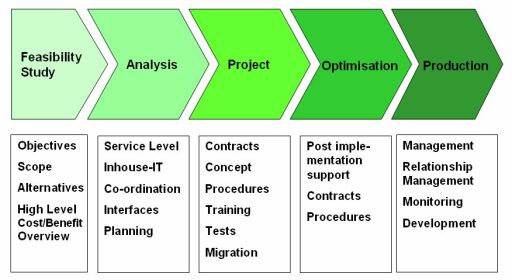
Challenge

In today's difficult market situation cost reduction without losing service quality is not only a permanent demand but under intensive and strategic discussion.
Since producing IT Services is certainly not a key business focus of banks and therefore often not within their key competencies, the idea of saving costs or increasing their flexibility by buying such services from specialised providers is obvious, e.g. sharing external connections to SWIFT or Reuters etc. with other banks will reduce their own costs in this area. But where should you draw the line?
Therefore, the challenges are plentiful: Which services might be outsourced without compromising on the competitive edge? Is this an option at all when confidentiality of data is of utmost priority? How to maintain the quality and flexibility of services? How to judge, which internal IT costs and which outsourcing prices are justified for the respective service provided?


Solution

Every approach to outsourcing must carefully consider four main areas:
 |
 | What are the benefits in terms of cost savings, flexibility, service level gains? |
 | What are the potential costs in terms of replacing assets by variable costs, loss of control over involved personnel, potential loss of individuality of services? |
 | What are the risks involved in terms of confidentiality of data and services, dependence on the supplier, loss of flexibility? |
 | Which internal processes - in IT and beyond - shall be reasonably included in the outsourcing process? Back-office processes in general do not define the quality of customer service or the competitive position of the bank. |
 |
Our Approach

Our approach will answer the questions above in a systematic way that will lead to an open, transparent process through to the final decision:
We start with a feasibility study in order to identify critical success factors like:
 |
 | Service level required (scope and quality) |
 | Potential rewards |
 | Pricing strategy |
 | Security and confidentiality |
 | etc. |
 |
The subsequent analysis of options takes into account e.g.
 |
 | The business framework identified in the feasibility study |
 | The capabilities / cost level of the internal service provider (IT department) |
 | The capabilities / cost levels of potential external service providers |
 | Management preferences (qualitative decision criteria) |
 | Experiences of peer companies |
 |
This phase results in a recommendation presented to the top management
If a principle decision on outsourcing has been taken, a detailed SLA will be developed incl. issues like
 |
 | Business Terms and Conditions |
 | Service Definition (scope, quality, and measurement) |
 | Portfolio Definition |
 | Performance Categories / Measurement |
 | Escalation Criteria |
 | Responsibility Matrix |
 |
Based on this a transition plan for moving the selected services to the new service provider will be established and its execution closely monitored.
|

